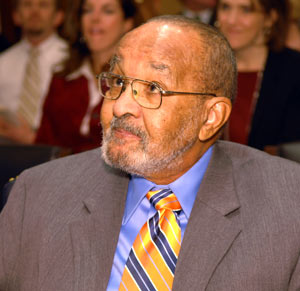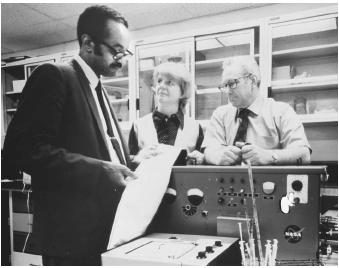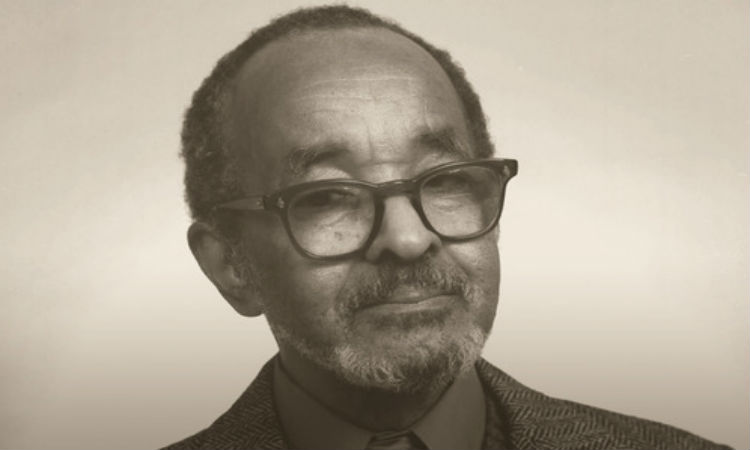Emmett Chappelle is an African American scientist who has made valuable contributions in several fields: medicine, philanthropy, food science, and astrochemistry. Chappelle is the recipient of 14 U.S. patents and has been honored as one of the 100 most distinguished African American scientists of the 20th Century. For his work investigating the biochemistry of life, Chappelle has won numerous awards including NASA’s Exceptional Scientific Achievement Medal.
 Emmett W. Chappelle was born on October 24, 1925 in Phoenix, Arizona to Viola White Chappelle and Isom Chappelle. He grew up on a small farm which did not have electricity until he was twelve. His family grew cotton and tended cows. Chappelle attended a one-room school for several years, but graduated from a small, segregated high school that was a part of the Phoenix Union High School District in 1942. He was the top graduate in his 25-student senior class. After graduating he was drafted into the U.S. Army and was assigned to the Army Specialized Training Program, where he was able to take some engineering courses. He was later reassigned to the all-Black 92nd Infantry Division and served in Italy. Chappelle was wounded in action twice. After returning to the U.S. in 1946, he attended Phoenix College and studied electrical engineering. The GI Bill enabled him to continue his education and he went on to earn a Bachelor of Science from the University of California at Berkeley in 1950.
Emmett W. Chappelle was born on October 24, 1925 in Phoenix, Arizona to Viola White Chappelle and Isom Chappelle. He grew up on a small farm which did not have electricity until he was twelve. His family grew cotton and tended cows. Chappelle attended a one-room school for several years, but graduated from a small, segregated high school that was a part of the Phoenix Union High School District in 1942. He was the top graduate in his 25-student senior class. After graduating he was drafted into the U.S. Army and was assigned to the Army Specialized Training Program, where he was able to take some engineering courses. He was later reassigned to the all-Black 92nd Infantry Division and served in Italy. Chappelle was wounded in action twice. After returning to the U.S. in 1946, he attended Phoenix College and studied electrical engineering. The GI Bill enabled him to continue his education and he went on to earn a Bachelor of Science from the University of California at Berkeley in 1950.
Chappelle went on to serve as an instructor at the Meharry Medical College in Nashville, Tennessee from 1950 to 1953, where he was also able to conduct his own research. His work was noticed by the scientific community, and he accepted an offer to study at the University of Washington, where he received his Masters in Science with a focus on biochemistry in 1954 but never completed a Ph.D. Instead he worked for various companies as a biochemist and during that period received the first of the fourteen U.S patents. In 1958 Chappelle joined the Research Institute for Advanced Studies in Baltimore, a division of the Martin Marietta Corporation which was famous for designing airplanes and spacecraft. There, he discovered that even one-celled plants such as algae, which are lightweight and can be transported easily, can convert carbon dioxide to oxygen. This discovery helped to create a safe oxygen supply for astronauts.
Chappelle went to work at Hazelton Laboratories in 1963 as a biochemist; and in 1966, he joined NASA as an exobiologist (someone who engaged in the search for extraterrestrial life and the effects of extraterrestrial surroundings on living organisms) and astrochemist (the chemistry of astronomical objects and interstellar space). Chappelle worked on a number of projects including the Viking Spacecraft, developing instruments to collect and scrape soil from the Mars surface. Some of Chappelle’s most interesting work was in the area of luminescence, which is light without heat. While designing instruments for the Mars Viking spacecraft, he became interested in bioluminescence, which is warm light produced by living organisms. His work with bioluminescence had far-reaching applications not only in astroscience, but in the medical field as well. He used this science for detecting bacteria in blood, urine, and other biological fluids; this can help treat infections and medical conditions.
 In 1977 Chappelle moved to the Goddard Space Flight Center as a remote sensing scientist. His research led to his invention of a method for the detection of adenosine triphosphate (ATP), an important compound in all living organisms. Through the patented method he developed, exobiologists are able to more speedily detect bacteria outside the earth’s atmosphere. The presence of bacteria is considered strong evidence for extraterrestrial life. Chappelle also discovered a method for determining vegetation health through laser-induced fluorescence (LIF). Working with scientists at the Beltsville Agricultural Research Center, he advanced the development of LIF as a sensitive means of detecting plant stress. This meant a method for farmers/crop specialists to read plant health, adjust planting, and improve food production.
In 1977 Chappelle moved to the Goddard Space Flight Center as a remote sensing scientist. His research led to his invention of a method for the detection of adenosine triphosphate (ATP), an important compound in all living organisms. Through the patented method he developed, exobiologists are able to more speedily detect bacteria outside the earth’s atmosphere. The presence of bacteria is considered strong evidence for extraterrestrial life. Chappelle also discovered a method for determining vegetation health through laser-induced fluorescence (LIF). Working with scientists at the Beltsville Agricultural Research Center, he advanced the development of LIF as a sensitive means of detecting plant stress. This meant a method for farmers/crop specialists to read plant health, adjust planting, and improve food production.
Chappelle retired from NASA in 2001. During his 34-year career, Chappelle’s innovative research led to 14 United States patents, as well as external recognition as one of the top one hundred African Americans, scientists and engineers of the twentieth century, which has been documented in the Museum of Black Innovations & Inventions. He received many awards for his work including the NASA Exceptional Scientific Achievement Award. Chappelle produced more than 35 peer-reviewed scientific or technical publications, nearly 50 conference papers, and co-authored or edited numerous publications. Chappelle was inducted into the National Inventors Hall of Fame in 2007.
Emmett Chappelle is a member of the American Chemical Society, the American Society of Biochemistry and Molecular Biology, the American Society of Photobiology, the American Society of Microbiology, and the American Society of Black Chemists. Throughout his career, he mentored talented high school and college students in his laboratories. He lives with his daughter and son-in-law in Baltimore.
Source:
http://www.chemistryexplained.com/Ce-Co/Chappelle-Emmett.html#ixzz4O6DLN0eF
https://en.wikipedia.org/wiki/Emmett_Chappelle
http://www.thehistorymakers.com/biography/emmett-chappelle
http://www.blackpast.org/aah-chappelle-emmett-1925
http://www.nasa.gov/centers/goddard/news/topstory/2007/chapelle_award.html
http://www.myblackhistory.net/Emmett_Chappelle.htm




2 comments
I love that you’re a great African American that actually made something everyone talks about; so your name is heard!
Its so amazing. I love you.